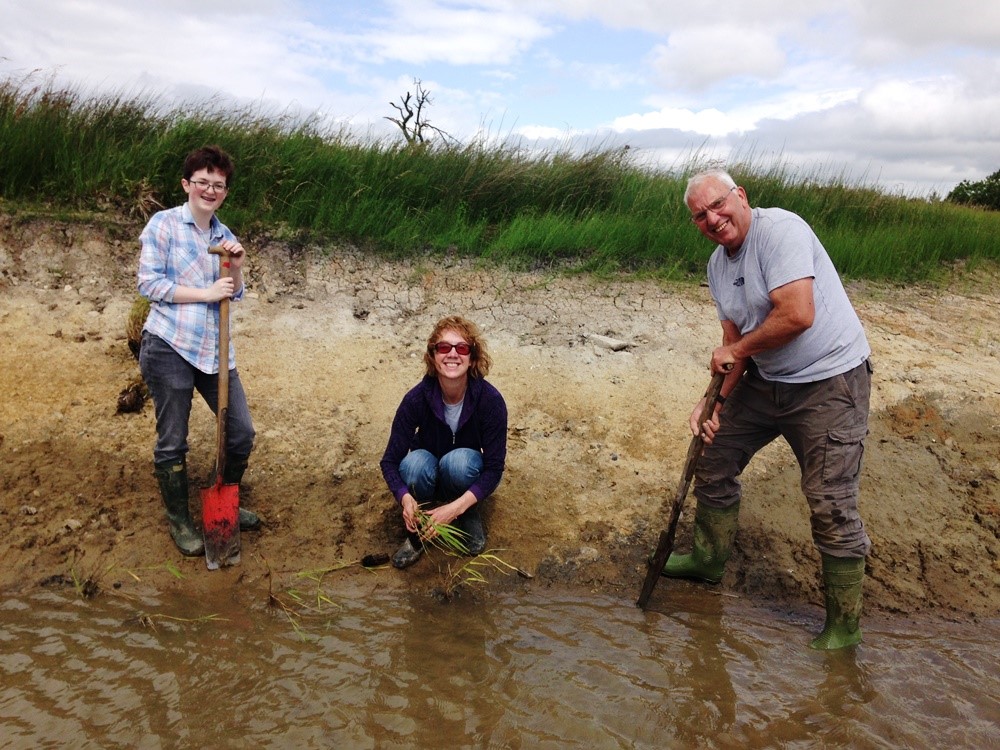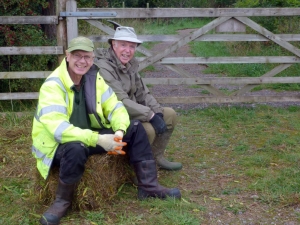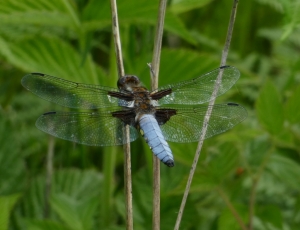Blog Archive (23) Posts Made in January 2016
Small and Large
Sunday, January 31st 2016
The bird ringers made the most of a window in the weather and raised the nets this morning. Nearly a 100 birds were caught and processed. Again there were several older birds recorded, some ringed in the nest box. The species ranged from Great Spotted Woodpeckers to Blue Tits, Greenfinches, Chaffinches and one or two Coal Tits!
Nuthatches are able to walk up and down a tree trunk, hunting for insects. They can place Hazel Nuts, Acorns, Beechmast and other seeds into crevices of the bark, where they break them open. A Nuthatch tips the scales at about 22g.
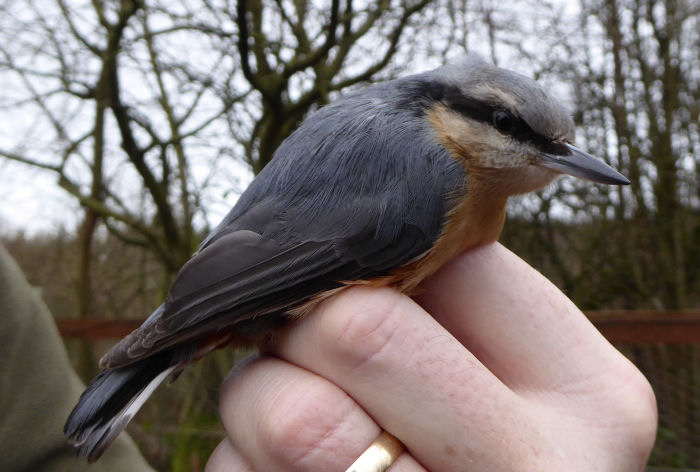
Long-tailed Tits fly around in flocks feeding in the tops of the trees. Usually they feed on insects but in autumn and winter can eat seeds. Increasingly these birds are to be found at peanut and suet feeders in gardens. These tiny birds weigh only about 8g.

At the other end of the scale, actually at the other end of the world, Stacey's Adelie penguins weigh about 4kg - but they are nothing like as cute as our resident Coal Tits or Long tails! On the reserve today just in the morning, we processed 92 birds of 14 species.

These chicks will fledge in about a week.
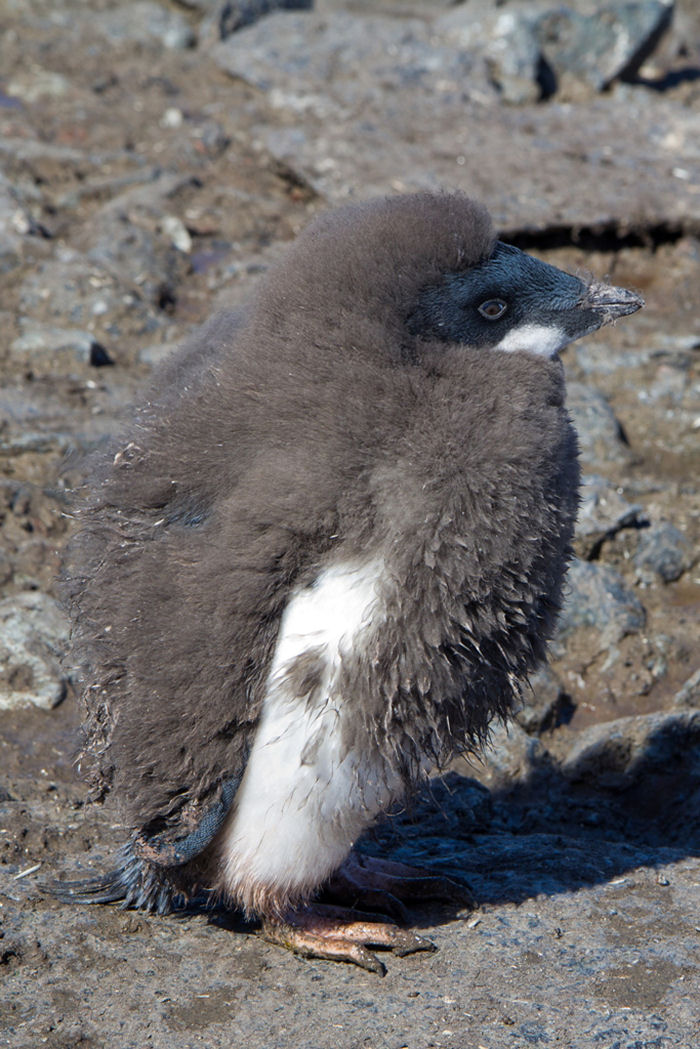
The Chinstrap Penguins are still being guarded by their parents and are about four weeks younger than the Adelie Penguins. Adults weigh between 3 to 5kg.

February tomorrow and we are begining to look forward to spring, leaving winter behind. Stacey's summer is past midsummer and heading to autumn.
In the early afternoon while we were tidying away, checking nets and bird bags a Tawny Owl was heard calling quite close to the Field Centre. Tawnies can have eggs by the end of February, so hopefully it was checking out one of the nest boxes.
1759 A Nicht Wi’ Burns 1796
Saturday, January 30th 2016
Many people spent a great deal of time organising, learning poems, rehearsing, preparing programmes and ensuring that all was ready. A huge thank you to them all.
During the afternoon the hall was arranged to receive the guests for A Nicht Wi' Burns.

The Haggis was piped in and

presented to Glennis who gave the Address to the Haggis.
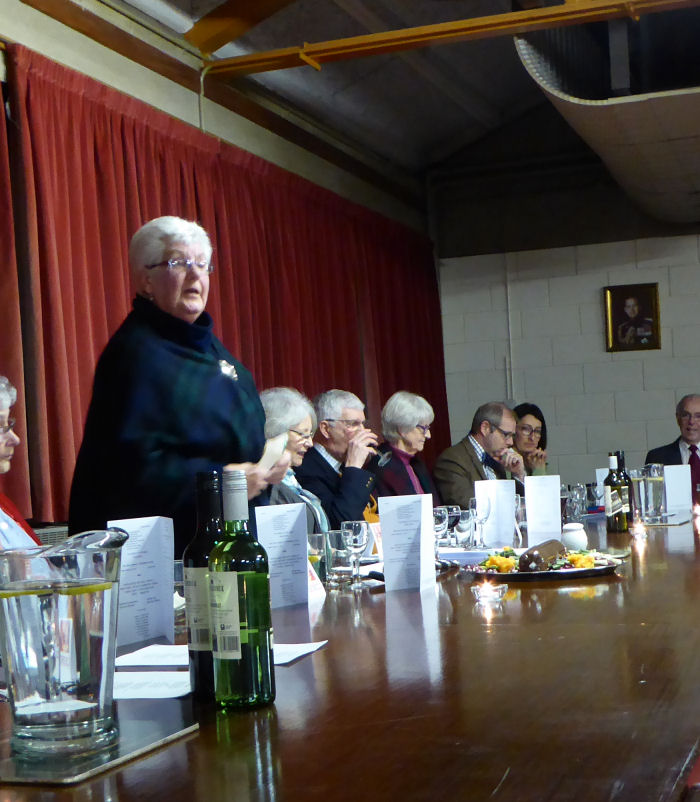
The menu as written in the programme:-
VARIOUS WINES BURN TROOT STRANG YILL
PENNY WHEEPS COO'S MATE GAIRDEN PEAS USQUBAE
HAGGIS CHAPPIT TATTIES BASHED NEEPS
COOFFEE TRIMLIN TAM
The meal was excellent and enjoyed by everyone.
A selection of pipe, accordion and keyboard music was played by Daniel and Baz during the meal.


After the meal The Ongauns began -
Perhaps it may turn oot a song
Perhaps turn oot a sermon.
The Toast: Immortal Memory was given by Tony. He told of the life of Rabbie Burns, a man who spoke his thoughts.
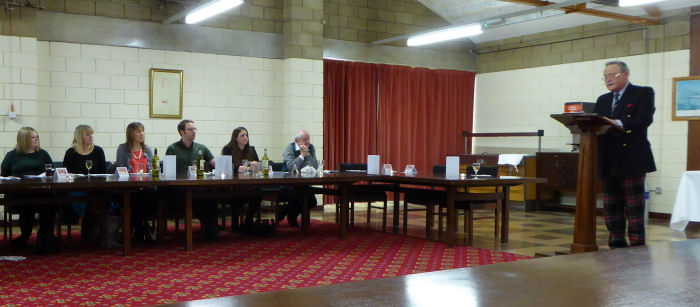
Leanne told of the Death and Dying Words of Poor Mailie, the poet's pet ewe. Sophie told the tale of a louse and a very posh person!

Tae a Mouse was read by Lisa whilst Sarah's recitation was To Simon Gray.
Phillip gave the Toast to The Lassies.

Songs were sung and we ended the evening singing Auld Lang Syne. (Last verse and chorus below.)
And there's a hand my trusty friend,
And gie's a hand o' thine,
And we'll tak' a right gude willy-waught
For auld lang syne.
For auld lang syne, my jo,
For auld lang syne,
We'll tak' a cup o' kindness yet,
For auld lang syne.
A Mixed Day
Thursday, January 28th 2016
Setting off with our small group of Thursday volunteers, leaving Tony and Mike behind in the workshop to carry on with mending owl boxes, the rest of us headed out to the woods and carried on burning the brash from Tuesday. We did this until lunchtime when the wind got up a bit too much and we had to call it a day. As there is a lot of dry wood on the forest floor we made the fire safe again by extinguishing it with water.
.jpg)
After lunch it was time for a spot of path maintenance, some of the edging along part of the yellow route not far from the small hide had rotted away, so we removed and replaced it and put in place new stakes to hold it together.

Thank you to everyone who came out today, your skills and hard work as always are appreciated.
New Habitat
Wednesday, January 27th 2016
Work has been continuing throughout the week to dig out our newest habitat improvement; a large scrape on the moor.

The scrape is intended to provide a suitable feeding and resting area for declining wader species. The creation of this much needed habitat involves some major earth works to create a level football pitch sized area which will fill with approximately nine inches of water.

There will be a lot of exposed mud around the margins of the scrape to provide easy access.. The project has attracted quite a bit of media attention and we were visited by BBC Radio Teesside today and you can read more about it in the Northern Echo.
Wet and Windy
Tuesday, January 26th 2016
Despite the inclement weather forecast we had a good turnout of volunteers this morning and to start with the rain was not very heavy. Our intrepid duo of Ken and Eddie headed out onto the wetland to do some strimming, whilst the rest of the group retreated to the woodland to tidy up some of the brash piles and dispose of them on a bonfire.

We carried on working till around lunchtime, as by that time the wind had got much stronger and was gusting making the fire too fierce and unpredictable. To make it safe, we let it die down, then formed a human bucket chain and extinguished it with water from a nearby burn.
The weather plays a big part in the management of the reserve, whilst it rarely ‘stops play’ we do have to think carefully about what jobs we can safely do when the weather gets a bit extreme.
Thank you to everyone who turned out today, as always your efforts are much appreciated.
Weather and Species
Sunday, January 24th 2016
We talk about good winters and bad ones, dry, wet, cold or too warm springs and so it goes on. Conditions that are good for one species may spell disaster for another. The moth trap has not been out for several weeks due to bad weather. This week it was set but not a moth in it.
Usually at this time of year we catch Mottled Umber moths. Larval food plants include Pedunculate and Sessile Oak, Downy and Silver Birch, Hazel, Blackthorn and Hawthorn. These food plants are important not only as the larva feed on them from April to late June, but the the female lays her eggs on the trunks to overwinter. The larva, which when fully grown may be 33mm long, uses a thread to leave the tree and drop to the ground. Here it burries into the soil and makes its cocoon.

Scarlet Elf Cup has been reported from some sites around Foxglove. None yet this year at Foxglove, well, at least not in its usual places. Has it been too warm for the fruiting bodies to develop, or has the recent cold spell caused problems?

Another winter fungus is Green Elf Cup, the fruiting bodies of which are not often seen, but the green stained wood can be more easily spotted. Usually it is hidden away, deep in the woodland, but this is out in the open. It is not sheltered from the elements so this may affect its development.

Walking up the quad bike track a greenish mound was glanced. Never been there before? On closer inspection it was found to be a lichen. No idea how we have missed it! It is growing in a very wet, mossy area of the heath.

Research by Christine and Jo has identified this as Cladonia furcata. Yes another new species for the reserve. This lichen is commonly found in woodland near the coast. It may be seen growing on soil, humus and moss. Extracts of this species have been shown to kill leukemia cells in vitro, and may have possible value in the treatment of cancer.

We are still awaiting the first Primrose. Has it been too warm for them over the winter so far? Many people are reporting the garden varieties in bloom. We will just have to wait and see what the weather throws at us and how the flora and fauna respond.
Hints of Winter Colour
Saturday, January 23rd 2016
Mild weather and some sunshine saw many visitors enjoying a walk around the reserve this afternoon. Although the reserve is still in its winter clothes there is a little colour to be spotted. Blackberries, enjoyed by humans, birds and small mammals during the autumn are long gone, but there are still some leaves showing colour.

Rose Hips are not enjoyed by many animals and remain on the prickly stems throughout the winter, although as the season progresses they look less than pristine.

Especially after rain, green lichens growing on branches can be easily seen.
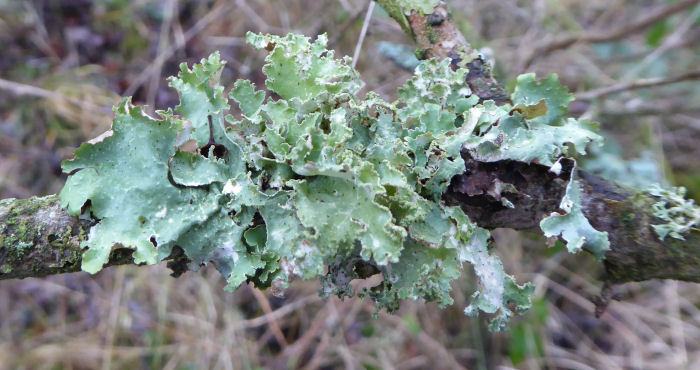
Green mosses cover some tree trunks and stand out against the dark bark. Some species can be found as tiny clumps on large stones.

Out on the moor there are hints of yellow as the Gorse is beginning to flower.

What Lies Beneath
Friday, January 22nd 2016
Today our contractor arrived to start digging out a wetland scrape on the moor; this is part of our habitat improvement works, as that area of moorland currently has little conservation value. It was fascinating to watch, as the skilled digger driver manoeuvred the bucket effortlessly peeling back thin layers of the vegetation to reveal mud. Much of this excavated soil will be used to create a ‘bund’ that will help retain the water.
The muddy outline of the shallow scrape will be its best feature, as this is the zone where we hope many wading birds will come to feed.
Good to Grow
Thursday, January 21st 2016
Today’s task for our small group of Thursday volunteers was to finish off the work on the orchid bank. On Monday a further section of brambles had been cleared with the brushcutter, so that was duly raked up and cleared away. Extending the cut area, we hope will allow the orchids to spread. Another small area was brushcut today, to use as a fire site, while Matt took down some old willow trees with the chainsaw, so there was plenty to burn!
The area looks totally different now, so we just need some spring warmth and hopefully the Early Purple Orchids along with other flora are good to go!
Thank you to everyone who helped today, it was a cold start to the day but everyone left with a warm glow!
A Hunk Hunk o’ Burning Brash
Tuesday, January 19th 2016
Another dry day, graced briefly by the sun in the afternoon. A good day for bonfires!
The majority of the volunteers set to work on the brash from recently felled trees in the plantation area near the car park. They were joined later on by the Dales School, who love this kind of task.


Once again, a small party walked the plank over to the island, behind the scrapes, to finish off cutting back Willow and very leggy Wild Rose.
The island looks very different to what it did a few weeks ago, although it looks a tad bare just now, in a few weeks it will be much more colourful, evidence of new growth was seen all over. Roll on Spring!
Thank you to everyone who helped out, it was an enjoyable day and a lot of work was achieved.
Surprise Snow and Birds
Sunday, January 17th 2016
Although the forecast had at one point mentioned a light covering of snow overnight it was a bit of a shock to the system to arrive at a snow covered FGC, especially when home had been snow free.
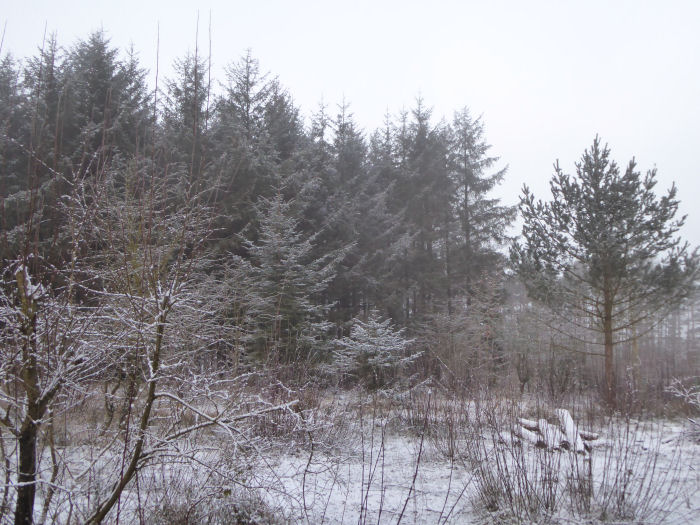
As can be seen by the reflections in the Voley Pond, there may have been snow but there was no wind, so much bettter conditions for mist netting than of recent weeks.

Setting out to raise the nets, the Roe Deer had been there before us.

Most of the vegetation had snow on it somewhere. Last year's Oak leaves were very attractive with their attached bits of snow
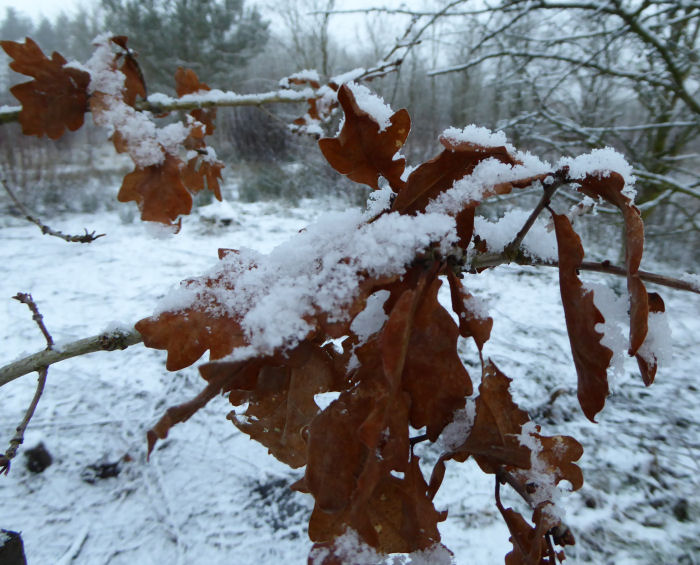
Angelica seed heads proved ideal for snow to rest upon.

Although there is little variation in colour at this time of year, the snow covered Teasel heads and dock seed heads, with a background of reeds, actually make a colouful photograph.

Outside there was little stirring, although the bird feeders were busy. No Invertebrates were to be seen at all, as one would expect. Peter found this spider enjoying the warmth of the kitchen. A very sensible spider!

Throughout the day the very well wrapped up bird ringers went on their net rounds. Many of the birds were retraps, as is the case at this time of year. Coal Tits flock to FGC for the winter as they know there is food for them. Come spring they disperse to the conifer blocks surrounding the reserve to breed. Lesser Redpolls have been seen feeding and some arrived in the ringing room.
Long-tailed Tits are tiny birds, weighing less than 10g. They are a delighful bird to photograph as they almost seem to ask 'Is this my best side?'

When the data for a retrapped bird is entered into IPMR, its first capture details are shown. From this we can actually age the birds. Today we caught 178 birds of 15 species - 67 of them were Coal Tits which is an amazing number, 17 of them new ones. One Blue Tit today was 9 years old, and additionally there were 2 birds at 4 yo, 6 at 5 yo, 1 at 6 yo and 1 at 7 yo. It was a fun and enjoyable day. Thank you to everyone who helped.
EPO’s
Saturday, January 16th 2016
Not aliens, but Early Purple Orchids. The area where these plants grow has been cut, removing all the Brambles. We always expect the orchids to appear, early, as the name suggests, but in reality we are just plain impatient. We check regularly and there is nothing. Then possibly a hint of a leaf, go away and come back another day and yes the leaves are there. By now we are wondering if they are ever going to flower. Suddenly there is one, then two and the area is covered in purple flower spikes. There were over 100 last year.
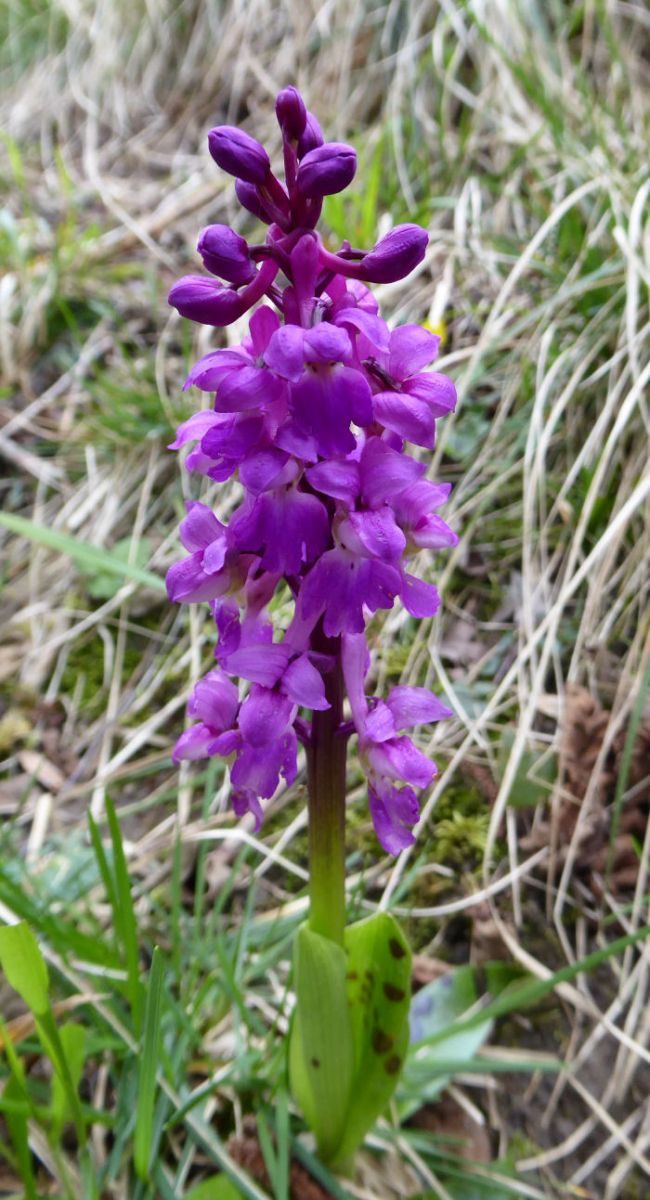
Our Common Spotted Orchids take great pleasure in hybridising and leaving us scratching our heads as to their parentage. Thankfully the EPO's don't do that, well they haven't done so far! They do show some variety in the marking on the petals.

Common Dog Violets can also be found growing amongst the orchids.

Wood Anemone, also known as windflower, thimbleweed and smell fox, because of the musky smell of its leaves, open their petals as soon as the sun shines. This plant is very slow to spread, only six feet in 100 years and consequently is an indicator of ancient woodland. Growth of the root structure is responsible for its spread rather than the dispersal of its seeds.

Another flower that will benefit from the area being cut is Primrose. We have discussed if, after last year's early flowering we would be treated to the same this year. Not so far.
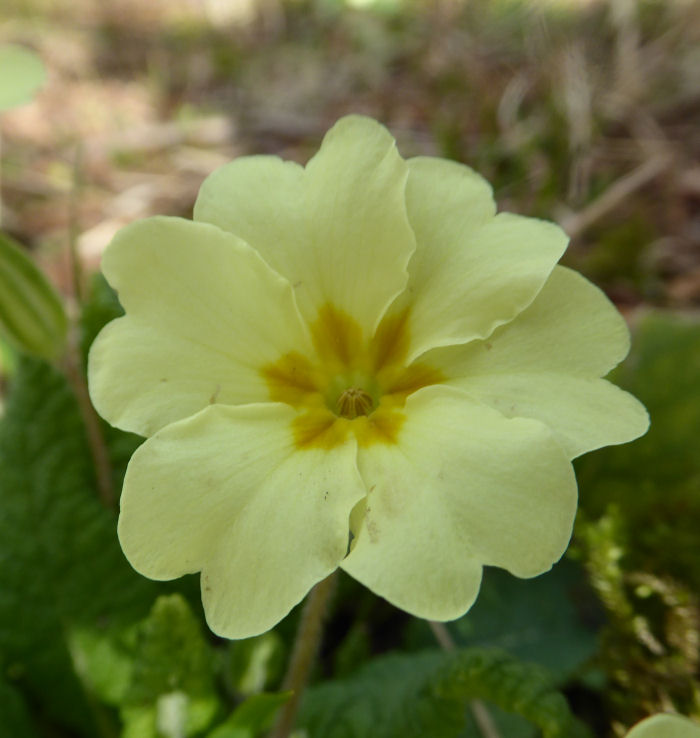
A Winter Wonderland
Thursday, January 14th 2016
Well its definitely feeling a lot like winter today. Foxglove looked stunning in the snow.
A snow flurry this morning however, did not stop our group of volunteers venturing out and doing a spot of raking on a section of the orchid bank that was cleared of brambles/ grasses with the brushcutter yesterday. This will allow the orchids to thrive, further sections will be cut in the following weeks to encourage the orchids to spread.

In the afternoon the group headed out onto the wetland to repair a bund on one of the ponds. It was a sticky situation to say the least but boards were tapped down into the breached area, held firm with small stakes then sealed off with ‘puddled’ clay.
Many thanks go to our volunteers for coming out on such a bitterly cold day and achieving more than was expected.
Stepping Out
Wednesday, January 13th 2016
It actually felt a bit like winter today, dry and crisp with ice on the windscreen first thing. Quite a good day in fact for our visitors, like the Dales School to go for a walk around the reserve and today we also enjoyed welcoming a new group to Foxglove, Northdale Horticultural, who are based near Northallerton. After some quick refreshment and a look round the visitor centre we took them on a guided walk around the yellow route. Everyone seemed to enjoy themselves and a few photos were taken for their blog.
A few weeks ago on our blog we mentioned about our plans for the wetland area, to add some scrapes to it, today we moved another step closer to this, with the installation of a new access gate. We expect the creation of the scrapes to commence in the next few weeks.
Variety is the Spice of Life
Tuesday, January 12th 2016
A rare treat, a dry day, with the added bonus of some sunshine welcomed our volunteers this morning. Split into 3 groups, the largest of which headed off into the woodland to do some clearing up, whilst a team of two went to the Wetland to do some strimming of Rushes and Grasses. A third party returned to the island behind the scrapes to cut back more Willow and burn the brash.

The woodland group finished their task by lunchtime, so in the afternoon they filled in the potholes in the drive, which may just be timely, ahead of the predicted frost and ice.

Thank you to everyone who came out today, your hard work is appreciated. It was a very successful and enjoyable day.
Nest Boxes
Sunday, January 10th 2016
Yesterday the nest box team repaired or replaced 12 Tawny Owl/Kestrel boxes on the training area. This is not an easy job as there is sometimes a considerable distance to travel between the boxes and some way to walk from where landrovers have to be parked. Ladders, nails, hammers and sawdust all have to be carried to the site. Oh and not forgetting the boxes themselves!
You can see how wet the ground was and how high the river, after all the rain that has fallen.

Nest boxes for Tawny Owls need to be over 2.5m above the ground. A clear flight path is helpful but not necessary. This one might just fit the bill. From now on you will be able to hear the calls of the Tawnies as they begin to set up their territories. Some of the owls that have been ringed on the training area have used the same nest box for 16 years, which is amazing considering that the average lifespan is only five years.

Eggs are laid, from mid Feb through to late March, on the bottom of the box which our volunteers have given a thick layer of sawdust. Two to three white eggs are laid and hatch in about 30 days. Chicks fledge after 35-39 days.
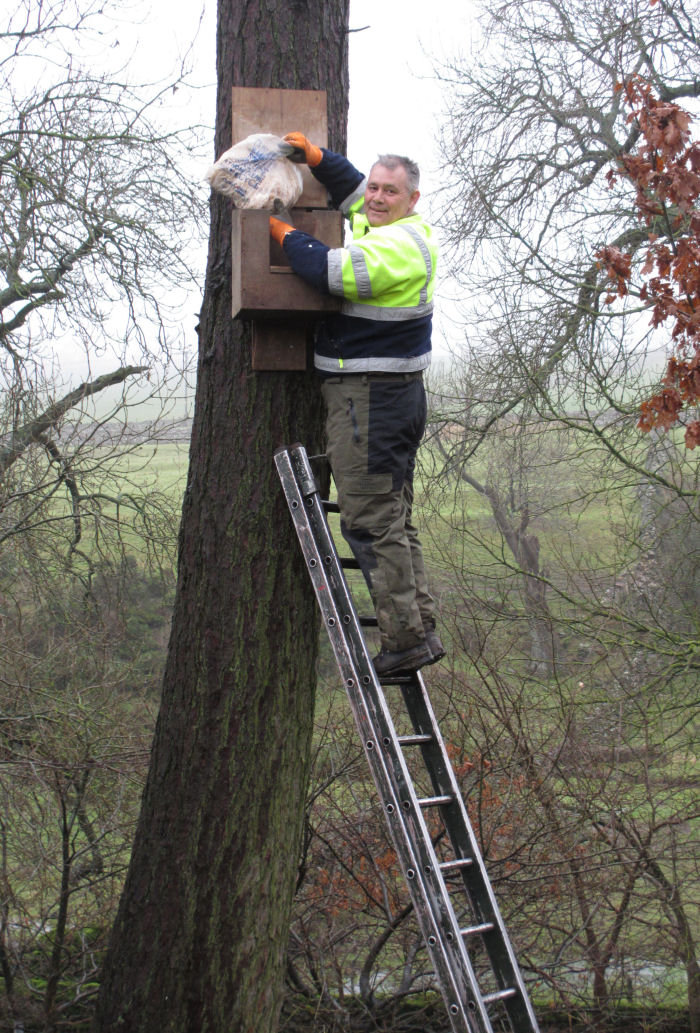
Hopefully, in a few months, we will very skillfully and carefully be catching and checking the adults and ringing the Tawny Owl chicks.

Kestrel boxes are placed about 4m above ground level. They nest later than the owls, from early April through to early July. Four to five reddish brown speckled eggs are laid, hatching about 28 days later with the chicks fledging after 32 to 37 days.
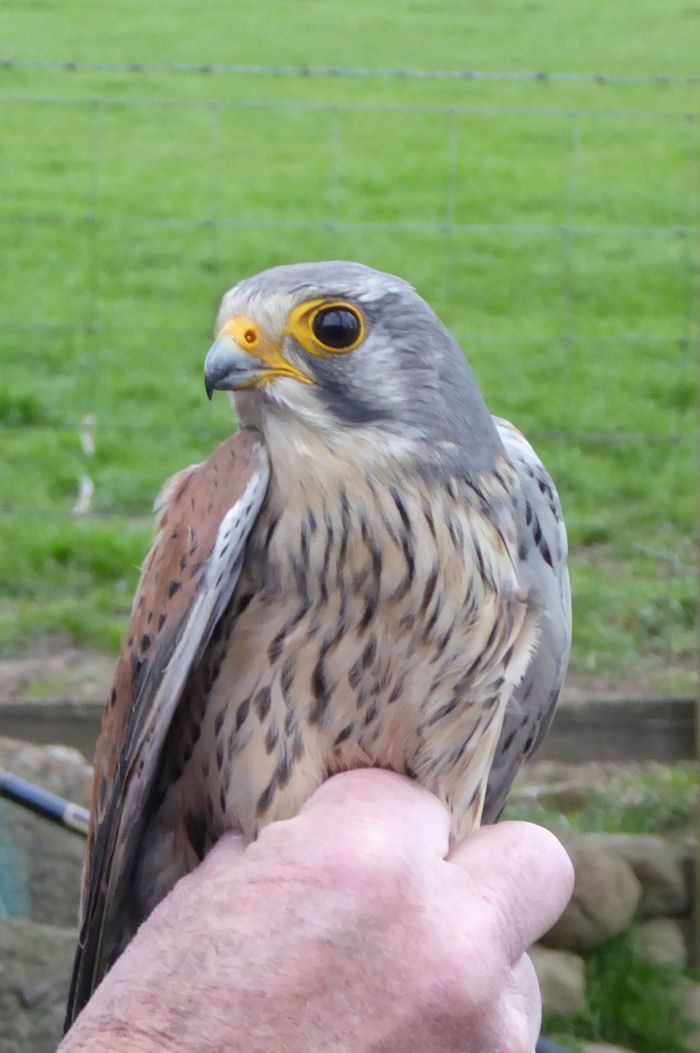
In both cases incubation begins as soon as the first egg is laid, so the age difference between the first chick hatched and last, can be 6 days in a Tawny Owl nest and more in a large clutch of Kestrels. If food is short then it is often the youngest birds that will not survive.
There are still four more boxes to replace/repair. We look forward to improvement in the weather to make the task a little easier! Thank you for the team for all their hard work yesterday.
PS The beginning of this blog mentions the amount of rain that has fallen over the last few weeks. Volunteers have been soaked and very muddy on numerous occasions. Sunrises and sunsets have been non-existent, until this evening. Leanne photographed this magnificent sight when leaving the reserve late this afternoon - what a stunning picture!

Winter Worky Day
Saturday, January 9th 2016
Despite the foggy start 35 people turned out today, for many it was their first time at Foxglove. We split into two groups, a small group of 8 went to work on the island near the Sand Martin wall, whilst the majority went into the plantation block. On the island we were cutting back overgrown stands of rose and coppicing willow, this will open the area up and be of benefit to the Primroses that grow there.
Meanwhile, in the wood, there was a lot of clearing up to do from the felling that had been done earlier in the week, which meant of course a blazing bonfire.

At lunchtime we all enjoyed a well earned sit down and a plate of curry, followed by tea and cakes. Yummy!
.jpg)
Thank you to everyone who came out today, much was achieved in wet and testing conditions. We hope you all had a good time despite the weather, especially those taking part in a Foxglove winter worky day for the first time. Please come back as/if/when the conditions improve and see the results of your hard work today!
Our Feathered Friends
Thursday, January 7th 2016
Today our small group of Thursday volunteers have had a focus on birds, helping to fill the many bird feeders on the reserve and repairing and building new large bird boxes, that we hope will be occupied by owls.

Last night, the ringing room at Foxglove was in use. A ‘murmeration’ of starlings had been spotted performing their spectacular pre-roosting behaviour at nearby Brough Hall on the edge of the Garrison. Mist nets were set up at lunchtime in preparation of the catch. The ringers waited with baited breath as upwards of 12,000 birds swirled above, the potential size of the catch was enormous.

However, the starlings proved to be somewhat canny and only a small number flew into the nets, a total of 19 starlings and 6 blackbirds but it was a good opportunity to see close up the beautiful plumage of this bird species, the indoor photography doesn't do it justice but you can just make out its purple and green iridescent hues.

If you are out and about around dusk in the Brough Hall area, glance upwards, you might be lucky and catch a glimpse of one of natures’ wonderful displays.
Thank you to our volunteers for your hard work today, we appreciate the time and skills you commit to the running of the reserve.
Ticket to Ride
Tuesday, January 5th 2016
Much to our surprise and against the odds, the weather has remained dry today, making it much more pleasant for our Tuesday volunteers. This morning we ventured out just beyond the edge of the reserve on the middle moor and cut a ride in a large patch of Gorse, all the way down to the fence abutting the wetland area.

This is preparatory work, the ride will be large enough for a digger to get through (once the fence has been cut down and a gate put in) the digger, which will hopefully begin work soon, will be creating a new wetland habitat for the reserve – a scrape. This will be a shallow pool, only about a foot in depth at its deepest, with lots of muddy edges that we hope will attract wading bird species, such as, Redshank, Snipe, and Lapwing.

Today we were rewarded with several sightings of a Barn Owl quartering over the training ground in the distance. Also spotted growing on some Gorse stems was the early growth stage of the Yellow Brain fungus, pictured here. As it matures it turns a vivid orange colour.

With many hands that task was completed by lunch time and in the afternoon we turned our attention to the woodland, where we checked over the saplings growing in tree guards, replacing tubes or stakes as necessary.
We have accomplished a good deal today, thank you to all our volunteers for your hard work and enthusiasm.
New Year’s Resolutions
Monday, January 4th 2016
The top of many peoples new years resolutions list is to join the gym and for many the enthusiasm starts to wane probably by er… February…..I have a theory for that, gyms are pretty boring. Well we can offer you a Free, yes Free alternative, it's a green gym and we have an 'open day' this Saturday 9th January. Join us for our January Winter Worky Day, work off some mince pies, doing some valuable conservation work, then enjoy a curry! Yes, this is no ordinary gym. So ditch the treadmill and immerse yourself in the Great Outdoors…....you know you want to!
If you would like to come on Saturday, we start at 10am, please give the Reserve Managers a call or email so we can arrange the catering accordingly.
Water
Sunday, January 3rd 2016
As it is wet, a trawl through the images taken during spring and summer last year, found some 'nice' wet photographs.
Lichens with cups live up to their name and often catch rain in their cups.

This developing larch cone has trapped water droplets.

The seeds of this dandelion like flower have suffered due to the rain.

Petals of flowers always catch water. Water droplets on the petals of Greater Spearwort appear to be glued on!

Dog Daisies make ideal subjects to photograph with or without water attached.

Birds
Saturday, January 2nd 2016
Due to the wet and windy weather over the last weeks there has been very little bird ringing. Last week, Jack, who rings down on Salisbury Plain, managed a short time before the weather closed in. He caught this Corn Bunting.
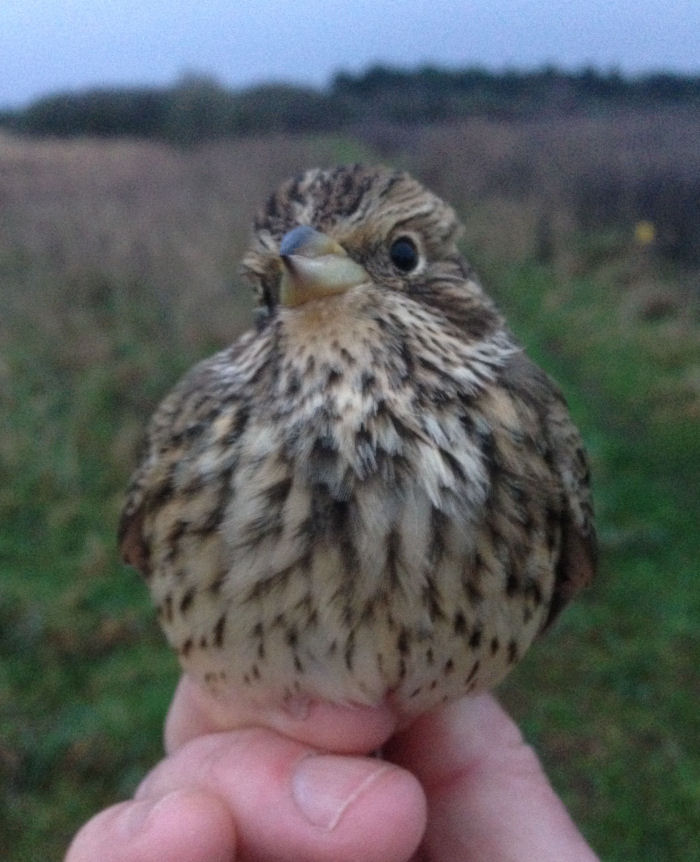
As the name suggests its preferred habitat is a corn field, although it will frequent other open spaces where there are few trees.

Once the holidays are over thoughts turn to the breeding season and the nest box records are checked to see which bird boxes need to be repaired or replaced. Armed with nails and hammers, sawdust and ladders the bird ringers set off to ensure that the boxes are safe for the birds.

Once checked they are ready for Tawny Owls, Kestrels or Jackdaws.

A Good Start to the New Year
Friday, January 1st 2016
Firstly best wishes for a happy and peaceful 2016. Thank you to everyone for all the friendships, laughter, sausage rolls, stickies, species recording, rooting and hardwork that you have given to FGC during 2015, making her a very, very special place. There is much to look forward to, volunteer days, school groups, guided walks, bird ringing, the nest box season, CES and of course more stickies!
Several visitors, some old friends and some new to the reserve, were treated to a frost, no wind and no rain day!
Frost always gives opportunities for photography. Bridge rails out in the open, had a vertical coating on top and slightly wavy lines down the sides.
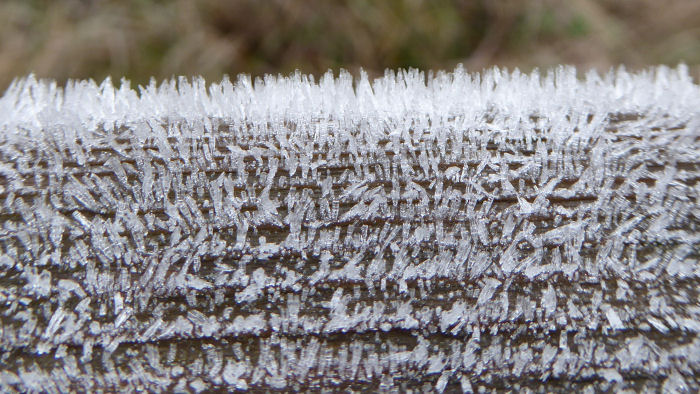
Phragmites also had a covering of frost.

Ice, coating puddles and ponds often give amazing patterns. No wind meant reflections too. It was not until we looked closely at this ice that we realised that it was actually above the water level. Speculation that the level had dropped since the ice formed.

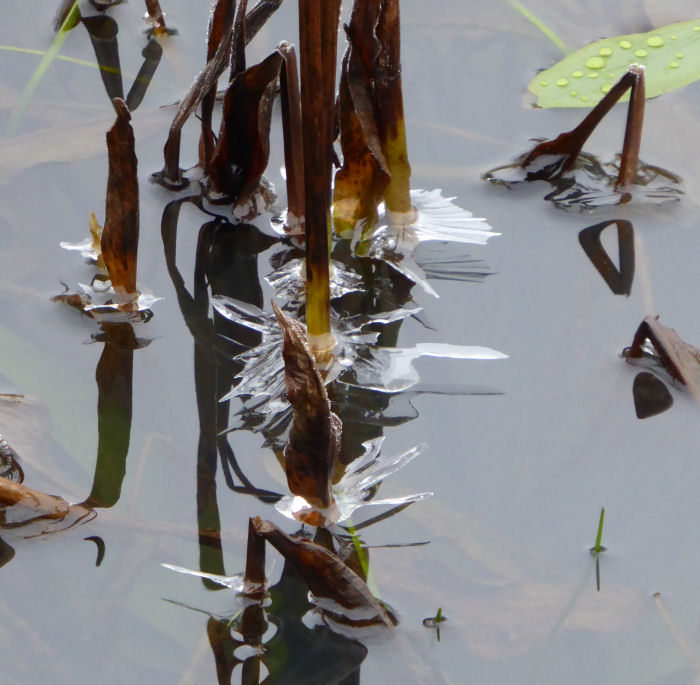
Sitting in the hide, binoculars scouring the edges, a quiet shout, the Kingfisher was sighted. This is when a huge lens is wished for and of course a pram, cart or wheelbarrow in which to carry it is also wished for! However as usual, pushing the camera to its limit photographs were taken. We watched the bird regurgitate at least two pellets. It then went fishing, twice near the edge of the lake and once in the middle. Three fish were caught. Surprisingly even after all the rain the lake is quite clear and not muddy.


Our walk continued over the bridge and the Kingfisher flew down the lake. A strategy was arrived at. People sit in the hide and one person walks quietly to the bridge and sends the Kingfisher back to the hide, where it will sit very, very close to the open window, so negating the use of a huge lens!








.JPG)



